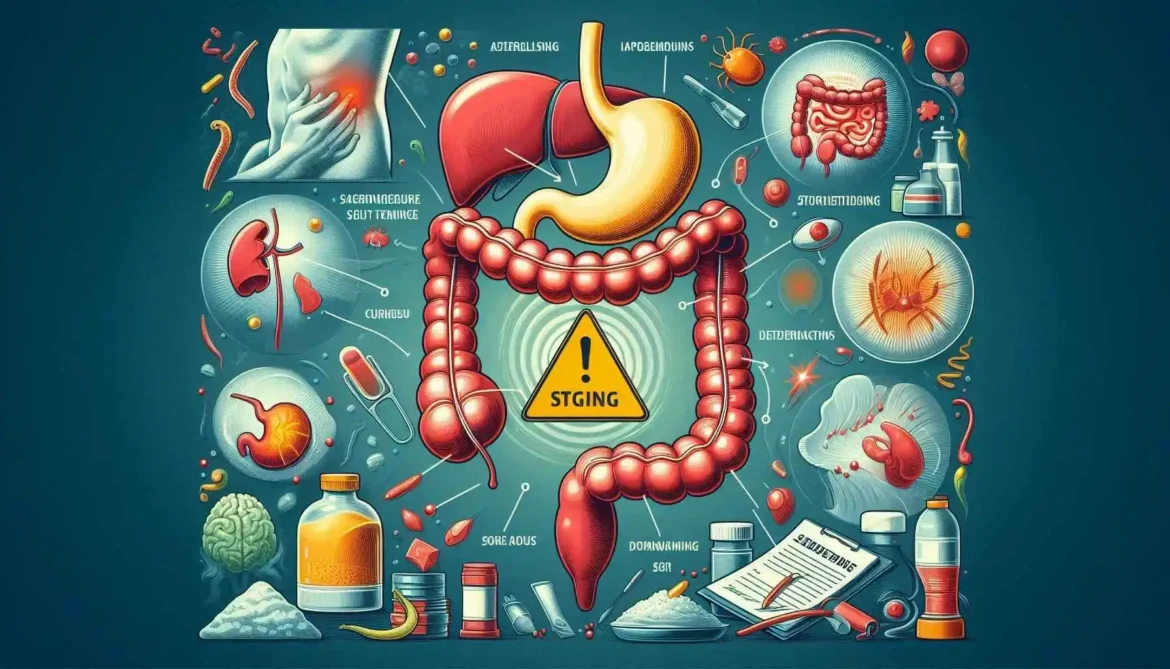Now, let’s look individually at the conditions mentioned, understanding their specific presentations.
1. Hepatitis (Inflammation of the Liver)
- Cause: Often viral infections (Hepatitis A, B, C), but can also be caused by alcohol, drugs, or autoimmune issues.
- Symptoms: We might feel a dull ache or tenderness in the upper right quadrant (URQ) where the liver is located. Other symptoms include fatigue, jaundice (yellowing of skin/eyes), nausea, vomiting, and loss of appetite.
- Treatment: Varies significantly based on the cause; rest, antiviral medications for certain types, avoiding alcohol.
2. Cholecystitis (Inflammation of the Gallbladder)
- Cause: Most commonly caused by gallstones blocking the cystic duct, leading to inflammation.
- Symptoms: Typically presents as sudden, severe, constant pain in the URQ, often radiating to the right shoulder blade or back, especially after eating fatty foods. We might also experience nausea, vomiting, and fever.
- Treatment: Often requires hospitalization, antibiotics, pain management, and usually surgical removal of the gallbladder (cholecystectomy).
3. Peptic Ulcer (Sores in the Stomach or Duodenum)
- Cause: Most commonly due to Helicobacter pylori (H. pylori) infection or long-term use of NSAID pain relievers (like ibuprofen).
- Symptoms: We might feel a burning, gnawing, or aching pain in the upper-middle abdomen (epigastric area). This pain can sometimes radiate to the back. It may be worse between meals or at night and sometimes relieved by food or antacids.
- Treatment: Medications to reduce stomach acid (PPIs, H2 blockers), antibiotics to treat H. pylori infection, and avoiding NSAIDs.
4. Pancreatitis (Inflammation of the Pancreas)
- Cause: Often caused by gallstones or heavy alcohol use, but many other causes exist.
- Symptoms: Typically involves severe, constant pain in the epigastric area, often radiating straight through to the back (described as band-like pain). We might experience nausea, vomiting, fever, and a rapid pulse. The pain is often worse when lying flat.
- Treatment: Requires hospitalization for pain control, intravenous fluids, and treating the underlying cause. In severe cases, it can be life-threatening.
5. Splenic Injury (Damage to the Spleen)
- Cause: Most often due to trauma to the upper left side of the abdomen or lower chest (like a car accident or sports injury).
- Symptoms: We might feel significant pain in the upper left quadrant (ULQ). A classic sign is Kehr’s sign – referred pain to the left shoulder, caused by blood irritating the diaphragm. Depending on the severity, we could also show signs of shock (dizziness, rapid heart rate, low blood pressure).
- Treatment: Depends on severity; ranges from strict observation and rest for minor injuries to emergency surgery to repair or remove the spleen for severe bleeding.
6. Renal and Ureteric Pain (Kidney Stones or Infection)
- Cause: Kidney stones blocking the flow of urine in the kidney or ureter, or severe kidney infection (pyelonephritis).
- Symptoms: Kidney stone pain, or renal colic, is notoriously severe, starting in the flank (the side of the back below the ribs) and radiating downwards to the groin, inner thigh, or even the testicle (in men) or labia (in women). It’s often wave-like and accompanied by nausea, vomiting, and sometimes blood in the urine. Kidney infection can cause flank pain, high fever, chills, and painful urination.
- Treatment: Pain management is key for stones, along with fluids to help pass smaller stones. Larger stones may require procedures to break them up or remove them. Kidney infections require antibiotics.
7. Bowel Obstruction (Blockage in the Intestines)
- Cause: Can be mechanical (physical blockage like scar tissue, hernias, tumors, or twisted bowel) or functional (bowel muscles stop working temporarily).
- Symptoms: We might feel intermittent, crampy abdominal pain that can be diffuse or localized. Associated symptoms include severe nausea and vomiting (sometimes of fecal material), abdominal distension (swelling), and inability to pass gas or stool.
- Treatment: Depends on the cause and severity; often requires hospitalization, fluid resuscitation, relieving pressure (e.g., with a nasogastric tube), and often surgery to correct the blockage.
8. Aortic Aneurysm (Enlargement of the Aorta)
- Cause: Weakening and bulging of the wall of the aorta, the body’s largest artery. An abdominal aortic aneurysm (AAA) is a bulge in the part running through the abdomen. Rupture is a life-threatening emergency.
- Symptoms: Often asymptomatic until it ruptures. Rupture causes sudden, extremely severe, tearing pain in the abdomen and back, sometimes radiating to the flank or groin. It’s a medical emergency associated with signs of shock.
- Treatment: Asymptomatic aneurysms are monitored; larger ones may be repaired surgically. Ruptured aneurysms require immediate emergency surgery.
9. Appendicitis (Inflammation of the Appendix)
- Cause: Usually caused by a blockage in the lining of the appendix, leading to infection and inflammation.
- Symptoms: This classic presentation often starts as vague, crampy pain around the belly button (peri-umbilical area), which then shifts within 12-24 hours to become constant, sharp, and localized in the lower right quadrant (RLQ). We might also experience loss of appetite, nausea, vomiting, and a low-grade fever. Pain often worsens with coughing or walking.
- Treatment: Typically requires surgical removal of the appendix (appendectomy), usually laparoscopically.
10. Pelvic Pain (General)
- Cause: A broad term for pain in the lowermost part of the abdomen and pelvis. Can originate from reproductive, urinary, or gastrointestinal systems (like Irritable Bowel Syndrome or diverticulitis, discussed separately).
11. Diverticulitis (Inflammation of Diverticula)
- Cause: Inflammation or infection of small pouches (diverticula) that can form in the wall of the colon, most commonly in the lower left part.
- Symptoms: Typically causes constant pain and tenderness in the lower left quadrant (LLQ). We might also have fever, nausea, vomiting, and changes in bowel habits (constipation or diarrhea).
- Treatment: Mild cases may be treated with rest, dietary changes, and antibiotics. More severe cases may require hospitalization and sometimes surgery.
12. Ovarian Cysts (Fluid-filled sacs on the Ovary)
- Cause: Common occurrences related to the menstrual cycle. Complications like rupture or ovarian torsion (twisting of the ovary) cause pain.
- Symptoms: Most cysts are painless. Rupture or torsion causes sudden, severe, sharp pain on one side of the lower abdomen/pelvis, often with nausea and vomiting.
- Treatment: Pain relief; watchful waiting for simple cysts. Surgery may be needed for large cysts, those causing severe symptoms, or suspected torsion.
13. Pelvic Inflammatory Disease (PID) (Infection of Female Reproductive Organs)
- Cause: An infection of the uterus, fallopian tubes, or ovaries, often caused by sexually transmitted infections (like Chlamydia or Gonorrhea).
- Symptoms: We might experience pain in the lower abdomen or pelvis, often on both sides. This can be accompanied by fever, unusual vaginal discharge, pain during sex, and painful urination.
- Treatment: Requires prompt treatment with antibiotics to prevent long-term complications like infertility or chronic pelvic pain.
Common Accompanying Symptoms
Besides the pain itself, various symptoms can occur alongside abdominal pain, providing further clues to the underlying cause. We might experience:
- Nausea and vomiting
- Fever and chills
- Changes in bowel habits (diarrhea or constipation)
- Bloating or abdominal distension
- Loss of appetite
- Weight loss (in chronic conditions)
- Blood in stool or vomit
- Jaundice (yellowing of skin/eyes)
- Changes in urination (pain, frequency, color)
When to Seek Immediate Medical Attention
While many causes of abdominal pain are not life-threatening, some require urgent intervention. We should seek immediate medical attention if we experience abdominal pain along with any of the following:
- Severe, sudden-onset pain.
- Pain associated with trauma to the abdomen.
- Inability to pass stool or gas.
- Persistent vomiting, especially if it’s severe or contains blood or material that looks like coffee grounds.
- Fever and chills along with the pain.
- Abdominal rigidity or hardness when touched.
- Signs of shock, such as rapid heart rate, low blood pressure, dizziness, or confusion.
- Pain that awakens us at night.
- Pain associated with vaginal bleeding or severe pelvic pain in women, especially during pregnancy.
- Pain with difficulty breathing or chest pain.
As the anonymous saying goes:
“Listen to your body. It’s telling you something.”
And when it comes to abdominal pain, listening carefully and getting professional help is paramount.
Diagnosis and Treatment: A Personalized Approach
Diagnosing the cause of abdominal pain involves a thorough medical history (describing the pain, its location, timing, what makes it better or worse, associated symptoms), a physical examination, and often diagnostic tests. These tests can include blood tests (checking for infection, inflammation, organ function), urine tests, imaging studies (ultrasound, CT scan, MRI, X-lays), and sometimes endoscopy or colonoscopy.
Treatment for abdominal pain is entirely dependent on the underlying cause. It can range from simple measures like rest, dietary adjustments, and over-the-counter pain relief (though it’s often best to avoid pain relievers before a diagnosis, as they can mask symptoms) to prescription medications (like antibiotics, acid reducers, or medications for IBS) or even emergency surgery.
Conclusion
Abdominal pain is a common but potentially complex symptom. Understanding its intricate nature, including the concept of referred pain and the specific ways different conditions can present, helps us appreciate the importance of a thorough medical evaluation. From the dull ache of hepatitis or peptic ulcer disease to the severe, sudden pain of conditions like pancreatitis, kidney stones, appendicitis, or a ruptured aortic aneurysm, the abdomen is a hub for vital signs about our health.
We’ve explored just a few of the many conditions that can cause abdominal pain, highlighting the diversity of symptoms and potential seriousness. Ultimately, while learning about these conditions is empowering, we must remember that self-diagnosis is risky. When abdominal pain strikes, especially if it’s severe, persistent, or accompanied by alarming symptoms, the most responsible course of action is always to seek professional medical advice. Our bodies communicate with us through symptoms like pain; understanding this language, guided by medical expertise, is key to maintaining our health.
- Other Therapies: Depending on the diagnosis, treatments could include procedures to remove stones, drain abscesses, or manage chronic conditions.
Abdominal pain is a complex symptom presenting a significant diagnostic challenge due to the sheer number of potential causes and the phenomenon of referred pain. While we have explored common referral areas, causes, symptoms, and treatments, it is vital to remember that this information is for educational purposes only. Self-diagnosis based solely on symptoms described here is unreliable and potentially dangerous.
We urge anyone experiencing persistent, severe, or concerning abdominal pain to seek professional medical evaluation. A doctor can perform a thorough assessment, utilize appropriate diagnostic tools, and determine the correct cause of the pain, leading to effective and timely treatment. Understanding the basics of abdominal pain, including the concept of referred pain, can empower us to better communicate our symptoms to healthcare providers and recognize the warning signs that warrant prompt attention. Our health is our most valuable asset, and listening to our bodies’ signals, while seeking expert guidance, is key to maintaining it.
Medical Disclaimer:
The information provided on this website is for general educational and informational purposes only and is not intended as a substitute for professional medical advice, diagnosis, or treatment. Always seek the advice of your physician or other qualified health provider with any questions you may have regarding a medical condition. Never disregard professional medical advice or delay in seeking it because of something you have read on this website.



